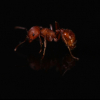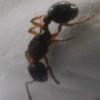I've got a big pack of test tubes all ready for queen collecting this summer, but about a week ago I noticed a lone Pogonomyrmex occidentalis wandering suspiciously far from any nests that I know of. I'm in Utah by the way.
I'm pretty positive I have eggs now, near the cotton and below the condensation, but are they most likely infertile being that we're so far out of season?
Thanks

























